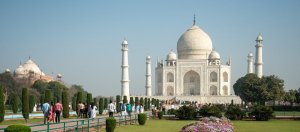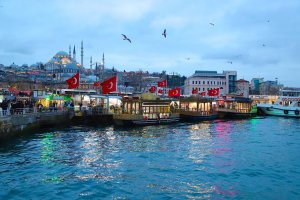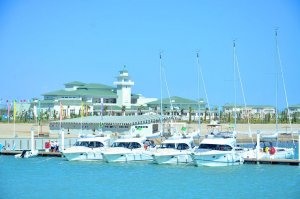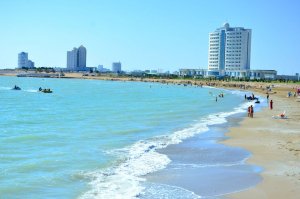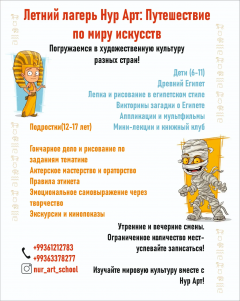Turkmenistan, being in Central Asia, has many similarities with the countries of the Asian region. Nevertheless, in this article we want to tell our readers about the 15 unique features that must be seen in one of the most ancient countries with elevated spirituality, primordial traditions and indescribable natural beauty.
1. Ashgabat, being the capital of independent and neutral Turkmenistan, deserves close attention, being distinguished by its architecture and dynamism.
The name of the city comes from the connection of two words “ashk” - love and “abad” - city. Therefore, the Turkmen capital is often called the "city of love", and also the city of youth, eternal youth - companions of love. A few years ago, Ashgabat was included in the Guinness Book of Records as the capital with the highest concentration of white marble buildings in the world.
2. In 2010, the National Museum of Wildlife of Ashgabat was built near Ashgabat.
Its location was chosen on the picturesque foothills of the Kopetdag, as the zoo is located on an area of 40 hectares, where any visitor, regardless of age, can in plenty observe the diverse fauna of the Turkmen land, but also enjoy the scent and aroma of the Turkmen land, fauna and unique beauty foothill plains and hills.
3. Akhal-Teke horses are famous all over the world.
Since ancient times, Turkmen have considered Akhal-Teke horses to be their national treasure. Akhal-Teke horse is depicted on the coat of arms of the country. Turkmenistan also celebrates the state holiday - "Day of the Turkmen Horse". A mandatory point of stay of guests in Turkmenistan is a visit to the “Bedev” racecourse in Ashgabat and the obligatory purchase of a souvenir with its image in memory.
The group of national equestrian games “Galkynysh” and the group “Turkmen horsemen”, well-known today far beyond the borders of our Motherland, actively popularize the heritage of the Turkmen people in the world. Over the past years, they have participated in a number of prestigious international competitions, having won many awards. One of the last is the golden statuette "Gaetano" - one of the main prizes of the 1st International Festival of Circus Art "On the Fontanka" in St. Petersburg.
4. Turkmen carpet is considered to be another world-famous heritage of Turkmenistan, bearing in its patterns historical memory, traditional originality, carried through centuries and glorified in centuries by the skill of carpet weavers.
At the National Museum of Turkmen Carpet, located in Ashgabat, it will be interesting for any tourist to learn the history of carpet weaving art, about ornaments unique to each Turkmen tribe, and listen to a historical legend that the covenants of the legendary progenitor of all Oguz Khan Turkmen are woven into the patterns of Turkmen national carpets. Also in the Museum you can see both ancient carpet artifacts and modern “carpet giants”, one of which is 301 square meters and weighs 1.2 tons and is listed in the Guinness Book of Records.
5. Turkmen melon, which occupies an honorable place in the same row with the Akhal-Teke horses and Turkmen carpets, is considered to be the gastronomic heritage of Turkmenistan.
430 main varieties of melons are distinguished and grown in Turkmenistan. The most popular and sought-after varieties of melons are “Vakharman”, “Gulyabi”, “Gurbek”, “Azgyn”, “Garpizgavun”, “Shakerpalak” and “Garagotur”. Turkmen melons possess not only excellent taste, but also unique healing properties and contain a number of vitamins and beneficial elements.
6. In the foothills of the Kopetdag, a few kilometers from Ashgabat, there is a unique monument of antiquity - the ancient city of Nisa - the ruins of the Parthian fortress, where one of the first capitals of the Parthian Empire was located from the III century. BC. on III century AD.
Even in spite of the fact that only grandiose ruins of past power have survived, they still amaze with their vaulted walls, skillful masonry, meaningfulness and integrity of architectural solutions.
7. In Mary province of Turkmenistan, not far from the city of Bairamali, there is one of the most ancient cities of Central Asia - Ancient Merv, which is part of one of the most ancient civilizations - Margiana. The history of Merv is characterized not only by dizzying highs, but also by falls. At one time it was one of the centers of the Parthian kingdom; was a book center under the Arabs because of the concentration of dozens of libraries: it was notable for its magnificent buildings under the Seljuks. In the beautiful Museum of Merv, you can get acquainted with the historical vicissitudes of events and destinies associated with this place, as well as explore many archaeological finds.
8. Another unique and complex architectural monument of the XI-XII centuries is the mausoleum "Astana Baba", which is included in the memorial ensemble consisting of a mosque and a tomb, which were built at different times.
The locals consider this place to be sacred and healing and periodically conduct a “zyyarat” - the so-called ritual of worshiping one or another saint, performed by visiting pilgrims. Every day the number of pilgrims is growing.
9. On the road from Turkmenabat to Khorezm there is a Caravan-saray Dayahatyn, located inside the walls of the Tahiriy Rabat.
In the northern part there was a huge entrance in the form of an arch, and the layout of the caravan-saray was symmetrical square, there is a covered vaulted gallery around the perimeter. The facade of the caravan-saray was decorated with an original ornament. Today, only the ruins of a caravan-saray have reached us; some fragments of text remain on some walls.
10. The center of the Muslim holy places is the ancient capital of North Khorezm - Kunya-Urgench.
Being for many centuries the rich capital of a prosperous state, its major cultural and commercial center of the Middle Ages Kunya-Urgench was also famous for its Academy of Sultan Mammun ibn-Mamun, whose pride were the great encyclopedist Abu Reyhan Mohammed ibn-Ahmed al-Buruni (973-1050) and brilliant naturalists, physician and philosopher Abu Ali ibn Sina, known in the West as Avicenna. With the passage of time, the remains of the former power and beauty of Kunya-Urgench have reached our days. But, to our happiness, a small number of ancient madrasahs, mausoleums, minarets and fortresses survived, with inherent mysteriousness and originality.
These and many other sights of Turkmenistan amaze not only the beauty of architecture and its age, but also its rich history, which is in each monument, so they are deservedly included in the UNESCO World Heritage List, and certainly worth a visit and see at least once in life.
11. The nature of Turkmenistan is very beautiful and diverse, and in each season it has its own zest. In the summer, it will be a special pleasure to visit the “Avaza” National Tourist Zone, a resort zone with dozens of modern hotels, amusement parks, and shopping centers located on the coast of the Caspian Sea.
To download the contact list of hotels, cottage complexes, health centers and yacht clubs at “Avaza” follow the link.
12. One of the most picturesque natural sites in Turkmenistan is Yangi-Kala Canyons, which means “FireFortress” in the Turkmen language, located deep in the steppes, 160 kilometers from the city of Turkmenbashi, next to which is the “Avaza” tourist zone.
The sheer cliffs that amaze imagination, skillfully carved by winds and rains, going down hundreds of meters, change the color of rocks depending on the time of day and light.
13. At the very east of the country in the Koytendag mountains there is a truly world-famous Turkmen “Plateau of dinosaurs” -inclined limestone slab four football fields with numerous dinosaur footprints.
14. Darvaza is a unique place in the territory of Turkmenistan, which is located in the Karakum desert. Photos from there at least once met on the Internet under the name "Gates of Hell."
It was discovered by Soviet geologists in 1971 near the village of Darvaza, which means “gates” from Turkmen. During the daytime, the crater looks harmless, but in the evening it sinks into dark gloom, which is highlighted by orange flames. The fact that the crater is in the desert without any settlements for many kilometers only strengthens the impression.
Do not miss the stunning photos of the gas crater in Darvaza "Gates of Hell" on this link.
15. The Bakharden Underground Lake or Kov-Ata Lake is the largest underground lake in the CIS, filled with warm healing hydrogen sulphide water. The lake's water contains 38 elements - iodine, potassium, calcium, magnesium, iron and others; hydrogen sulphide also plays its role. Because of this combination, water procedures here improve blood circulation, help to overcome rheumatism, colds, kidney and skin ailments, soothe the central nervous system.
Turkmenistan, being a modern dynamically developing state, was able to preserve, despite all the vicissitudes of history, its ancestral traditions, its individuality, with which it will willingly and generously share with every traveler and surprise his imagination.

